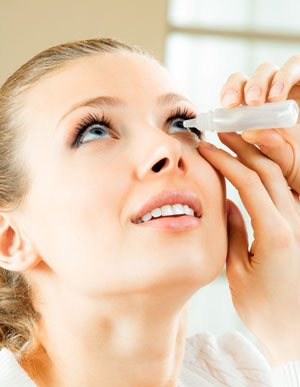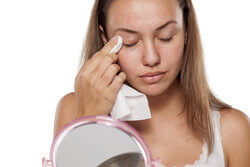Dry Eye / Blepharitis
Your tears have two major ingredients: water and oil. The diagnosis of “dry eye” can reflect a problem with one or both of these ingredients. The diagnosis of “blepharitis” (or “meibomian gland dysfunction”) more specifically refers to situations that include a problem with the oil.
In the vast majority of cases, no specific cause for dry eye or blepharitis is identified.
Dry eye and blepharitis can be very bothersome. Furthermore, these conditions can cause decreased vision. In certain cases, they can even lead to the formation of scars on the front surface of the eye.
Treatment for dry eye and blepharitis centers on improving the tears and increasing the lubrication of the eyes. It is very unusual for ALL symptoms of dryness to be eliminated, even with a combination of treatments. However, most of the time, a plan can be developed that succeeds in significantly reducing symptoms.
Dry Eye Treatment
 When the dryness is caused by not having enough water on the eye (but the oil is normal), the best treatment is the regular and dedicated use of artificial teardrops.
When the dryness is caused by not having enough water on the eye (but the oil is normal), the best treatment is the regular and dedicated use of artificial teardrops.
- Use 1 drop in each eye 2-4 times daily, each and every day
- Using your drops regularly is far more important than using any particular brand of drops. However, some over-the-counter brands that you might try include Systane, Refresh, Blink, and Soothe. Avoid any eye drops that are designed to ‘get the red out.’
If the regular use of artificial tears during the day is not enough to control your dryness, you can also try a lubricating ointment before bed. Unlike teardrops, ointments come in a tube. Clean your hands, squeeze a small amount of ointment onto your fingertip, and then gently dab the ointment onto the surface of your eye. Some common over-the-counter brands of lubricating ointments include Lacrilube, Refresh PM, and Genteal Gel.
In addition:
- Be sure to stay well-hydrated
- If possible, use a humidifier at work and in your bedroom
- Avoid makeup, soaps, and medications around the eye
Blepharitis Treatment
In blepharitis, the glands which produce the oil of your tears are not functioning properly. This causes the water to evaporate too quickly. In this way, the dryness in blepharitis is due to a problem with both the oil and the water.
Warm Compresses
The first and most important step in the treatment of blepharitis is the use of warm compresses. These compresses stimulate the oil glands to work better, and they also melt away any debris that might be clogging the glands.
- Many people are satisfied using a washcloth and warm water for the compress. However, commercial products specifically designed for the treatment of blepharitis (for example, a microwavable rice bag) will retain heat more effectively.
- The compress should be warm, but not scalding. If it is painful to place the compress on the eyelids, then it is too hot!
- Close your eyes and drape the compress over your eyelids. Leave it in place for 3 minutes, and then remove it.
- Warm compresses should be used twice daily, each and every day.
Lid Scrubs
The second step in the treatment of blepharitis is the use of lid scrubs. These scrubs reduce the number of bacteria on the eyelids and assist in keeping the oil glands open.
- Lid scrubs should be done immediately following the use of the warm compress (twice daily, each and every day).
- Create a 50:50 mixture of baby shampoo and warm water, and then apply this mixture onto a washcloth. Close your eyes, and gently scrub the eyelashes. If you would prefer to avoid mixing together your own solution, you can instead buy a commercial lid scrub (such as OCuSOFT) and rub your lashes with that.
Artificial Tears
The third critical step in the treatment of blepharitis is the use of artificial tears. These drops replace the water that is evaporating too quickly.
- Use 1 drop in each eye 2-4 times daily, each and every day
- Using your drops regularly is far more important than using any particular brand of drops. However, some over-the-counter brands that you might try include Systane, Refresh, Blink, and Soothe. Avoid any eye drops that are designed to ‘get the red out.’
In more severe cases, you can also try a lubricating ointment before bed. Unlike teardrops, ointments come in a tube. Clean your hands, squeeze a small amount of ointment onto your fingertip, and then gently dab the ointment onto the surface of your eye. Some common over-the-counter brands of lubricating ointments include Lacrilube, Refresh PM, and Genteal Gel.
In addition:
- The symptoms of blepharitis can be reduced by taking an oral supplement of omega-3 fatty acid (such as TheraTears Nutrition). Omega-3 is a key ingredient in the glands’ production of oil, and so having an adequate supply in your body is essential to the formation of good tears.
- Be sure to stay well-hydrated
- If possible, use a humidifier at work and in your bedroom
- Avoid makeup, soaps, and medications around the eye
In some cases of dry eye or blepharitis, additional treatment may be necessary. This could include the use of steroid eye drops, Restasis, or Xiidra to reduce inflammation; antibiotic eye drops or ointments to reduce the number of bacteria on the eyelids; oral medications (such as Doxycycline); or office procedures (such as the placement of punctal plugs or the performance of punctal cautery). These treatments have more serious side-effects, and they are therefore reserved for only those cases where they are absolutely needed.
Visit the American Academy of Ophthalmology’s EyeSmart® website to learn more about Dry Eye and Blepharitis.




